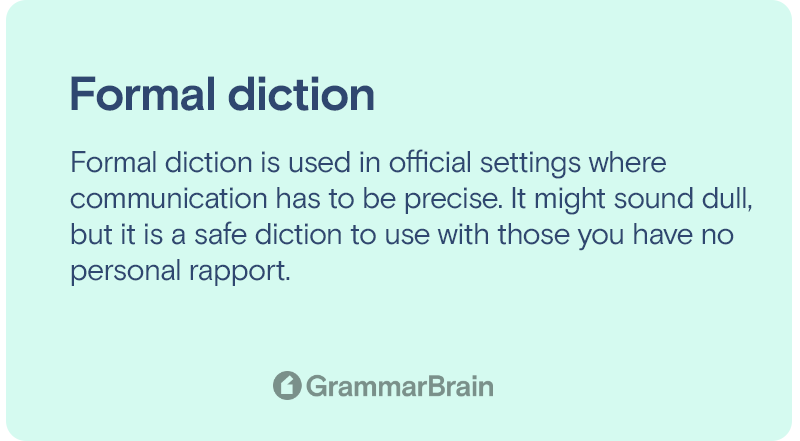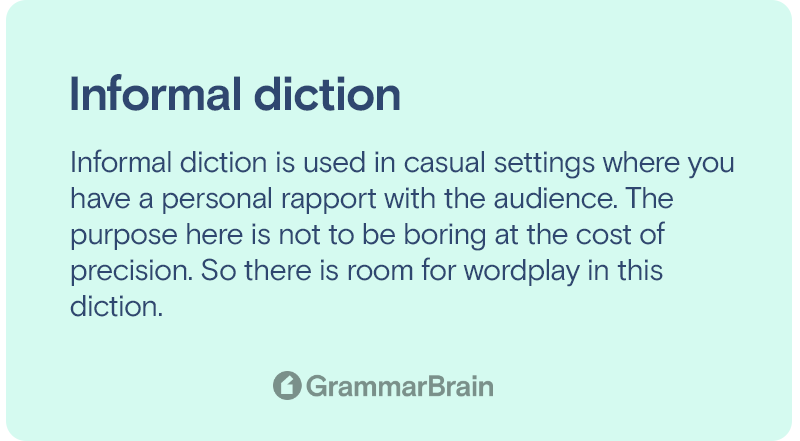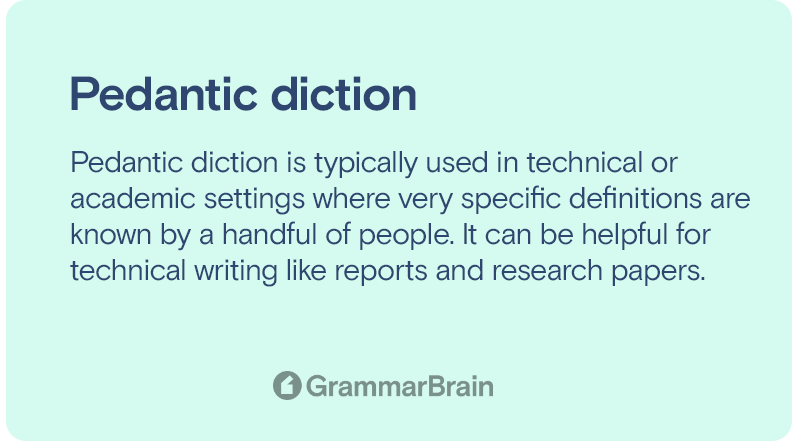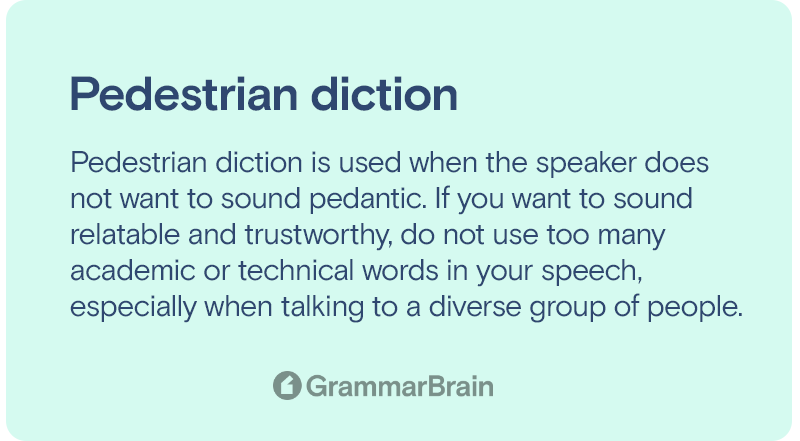What is diction? What are the various types of diction? And how are they different from syntax? These are all great questions that someone may have when learning about diction. Get answers to these questions and more in this comprehensive American English guide.

What Is Diction?
Diction is the precise choice of words used to convey a message in text or speech. Each combination of words that can relay the same message represents various examples of types of diction.
The choice of a particular diction represents the intention of the writer or speaker in terms of the tone they want to employ.
Diction changes based on the relationship between the writer or speaker and the reader or listener. It also changes based on the cultural and geographical context.
Definition of Diction
The specific articulation used in speech and writing in terms of words and phrases chosen is diction. Diction in writing and speech are different. But the intended recipient and the context affect both.
Characteristics of Good Diction
Good diction is when the style of speech or writing correctly conveys the intended meaning to the listener or reader.
It means that the words and phrases chosen are accurate and there is no misunderstanding of the meaning. It also means that the tone of delivery is ideal for the intended audience. This can be formal or informal based on the context.
Additionally, it also means that there is a deeper meaning in the choice of words, allowing the writer or speaker to convey subtextual meaning.
Good diction in speech is more directly related to clear pronunciation. But sentence structure and paragraph structure also affect good diction in writing.
What is diction in speech?
In speech, diction includes the choice of words and phrases. It also includes how you speak these words and phrases.
Altering the pronunciation of the words, the register of voice, and the enunciation of each sound will change the diction. The sum of all these components represents the tone of the speech.
The tone is particular to the context and the situation of what you say. With the exact words being used, the tone can make the distinction between formal and informal. But diction for speech can also simply mean enunciation or clarity of speech. A clear speaker who does not mumble and is properly intelligible has good diction.
Example
While addressing the class, a teacher will say, “Please pass all the answer sheets to the front of the class.”
But if you want to tell your classmate sitting in front of you to pass your answer sheet to the teacher, you will say, “Pass this to the teacher.”
This is a more informal manner of saying almost the same thing, and it is appropriate for the context.
What is diction in writing?
Diction in writing is different from diction in speech, although it is the expression of tone. In the absence of pronunciation, the tone is conveyed by choice of words, the structure and length of the sentences, and the structure and length of the paragraphs.
By choice of words, the reader gathers more than the literal meaning of the text. They can interpret the mood of a situation, whether it is severe or light-hearted. They can also make judgments about a character by the words they choose and the manner of speech they employ.
Example
If a character says, “The low-pressure systems seem to be merging,” you can infer that they are well-educated simply because of the use of scientific jargon.
So the writer can tell us about a character’s background without explicitly stating them.
How to form diction in writing
A good writer is adept at choosing the right diction when writing a piece. Through this simple choice, they achieve multiple goals at the same time. The purposes of using appropriate diction while writing are as follows:
Establishing the purpose
The right tone for a piece is informed by why the piece is being written. Journalists who want to report the news will use formal language with direct statements of facts.
They will minimize the use of flowery language and embellishments like metaphors unless it explains complicated or very technical concepts to a general readership.
The phrases and words they use will be less unfamiliar to the typical reader than those used in a technical report prepared by a researcher.
Creating cultural context
Diction is specific to time and region. The diction used in Victorian England was very different from the diction used in the UK today.
At the same time, the diction used in the UK differs from that used in the USA or the rest of Europe. So by using the proper diction, the writer can invoke a particular time and place in the mind of the reader, allowing them to immerse in the world created by the author entirely.
Evoke emotional response
With the proper diction, the author can create a particular emotional response in the reader. This is essential to underpin the tone of the narrative. The author might simply get the readers excited for an adventure or afraid for the protagonist’s fate at a moment of suspense by employing accurate diction.
Add personality to characters
Since diction is a surrogate for tone, using proper diction in the dialogues for characters may bring a character to life for the reader. They can imagine a living, breathing person speaking the words if the writer successfully captures the diction of a fictional character.
Are Diction and Syntax the same?
Diction is closely associated with the choice of words, whereas syntax is the arrangement of words to create meaningful grammatical sentences. While they are related, they are not the same.
The syntax is the order in which words appear to make grammatical sense and, as a result, is much more rigid.
But within the grammatical structure, diction allows for much flexibility in conveying different tones.
Examples
The words “I,” “ ate,” and “breakfast” must be ordered as “I ate breakfast” to convey the grammatical sense.
Any other combination will be meaningless. But “I’m full” is also grammatically correct, but it signifies a more informal diction.
Diction vs. Dialect
Various dialects or regional variations of a spoken language are different. This is because they use specific words and phrases uncommon in other regions.
Besides, the pronunciation of various vowels and consonants is unique to each region.
So the differences in dialects are differences in diction.
This means people of a particular region use a particular diction that differs from people from other regions. But dialect and diction are not identical. This is because even within a single dialect, the diction can change based on the context. Formal and informal speech is different even within the same dialect.
Examples
An Australian person will greet you with “G’day mate!” while an American person might say “Mornin’!” This is a difference arising from differences in dialects.
But how a teacher greets a class (“Good morning, class!”) and how you greet your friend (“Hiya!”) are different because of the difference in implied formality between the two.
The 9 types of diction
There are many types of diction. They each have their use. You must know them well to use them properly and develop a rich writing style because each conveys subtly different moods and is helpful in different contexts.

Formal
Formal diction is used in official settings where communication has to be precise. It might sound dull, but it is a safe diction to use with those you have no personal rapport.
Example
I humbly request that you do the needful at your earliest convenience.

Informal
Informal diction is used in casual settings where you have a personal rapport with the audience. The purpose here is not to be boring at the cost of precision. So there is room for wordplay in this diction.
Example
There are way too many math problems for me to get to today.

Pedantic
Pedantic diction is typically used in technical or academic settings where very specific definitions are known by a handful of people. It can be helpful for technical writing like reports and research papers.
In other settings, people deliberately use it to convey how intelligent and well-spoken someone is.
Example
Mimicry is ubiquitous as it has clear selective advantages in predator avoidance.

Pedestrian
Pedestrian diction is used when the speaker does not want to sound pedantic. If you want to sound relatable and trustworthy, do not use too many academic or technical words in your speech, especially when talking to a diverse group of people.
Example
I feel what you are saying, and I am hurting too.
Slang
Slang diction is part of informal diction. Here certain words are used with a definite meaning and context for select groups of people. This may include profanity but not necessarily so. Usually, these words are shorthands which change their meaning and implication across generations.
Example
The band played till 4 am, and the party was lit.

Colloquial
This is another extension of informal diction similar to slang diction. Here the context and meaning of specific words are tied to a locality. So people say “soda” in one part of the world to mean the same thing as “pop” in another. This difference is the colloquial diction of each place.
Example
Joey went out to get some soda.
Abstract
When discussing abstract concepts, it is impossible to be extremely precise. So the diction used in such cases has room for flexible interpretation. This is known as abstract diction.
Example
I knew something was off about the store as soon as I walked in.
Concrete
When you do not want to be abstract and want to convey precise information, you use concrete diction.
Example
There were seven people on the bus.
Poetic
Poetic diction is used when you want to create aesthetically pleasing groups of words using rhythm and rhymes. The language of poetry and music is poetic diction. New words may be created in this form by contracting existing ones to suit the rhyme and rhythm.
Example
- Open the doors
- Give up your fear
- The ice is melting
- Spring is here.
FAQs
What are the three common levels of diction?
The three most common levels of diction are formal, popular, and informal. Here the dictions are only different in their levels of formality. The language you use in the office is formal. The language used by your mother is popular. The language used with your friends is informal.
Are diction and enunciation the same thing?
Diction in speech is influenced by how words sound. So in speech, diction and enunciation are used interchangeably. But diction in writing is different from enunciation.
What are synonyms of diction?
Phrasing, articulation, parlance, vocabulary, and delivery are some of the synonyms of diction.
Why do we use diction?
We use diction to convey context beyond the literal meaning of words. This allows the writer or speaker to convey a richness of tone to the audience sub-textually.
What is phraseology?
Phraseology refers to combining words into related groups, and especially to the peculiar or distinctive manner. Usually certain technical, scientific, and professional ideas are expressed.
What does it mean to have excellent diction?
This is a type of phrase used to say that someone’s speech or vocal abilities is strong.
Inside this article
Fact checked:
Content is rigorously reviewed by a team of qualified and experienced fact checkers. Fact checkers review articles for factual accuracy, relevance, and timeliness. Learn more.
Core lessons
Glossary
- Abstract Noun
- Accusative Case
- Anecdote
- Antonym
- Active Sentence
- Adverb
- Adjective
- Allegory
- Alliteration
- Adjective Clause
- Adjective Phrase
- Ampersand
- Anastrophe
- Adverbial Clause
- Appositive Phrase
- Clause
- Compound Adjective
- Complex Sentence
- Compound Words
- Compound Predicate
- Common Noun
- Comparative Adjective
- Comparative and Superlative
- Compound Noun
- Compound Subject
- Compound Sentence
- Copular Verb
- Collective Noun
- Colloquialism
- Conciseness
- Consonance
- Conditional
- Concrete Noun
- Conjunction
- Conjugation
- Conditional Sentence
- Comma Splice
- Correlative Conjunction
- Coordinating Conjunction
- Coordinate Adjective
- Cumulative Adjective
- Dative Case
- Determiner
- Declarative Sentence
- Declarative Statement
- Direct Object Pronoun
- Direct Object
- Diction
- Diphthong
- Dangling Modifier
- Demonstrative Pronoun
- Demonstrative Adjective
- Direct Characterization
- Definite Article
- Doublespeak
- False Dilemma Fallacy
- Future Perfect Progressive
- Future Simple
- Future Perfect Continuous
- Future Perfect
- First Conditional
- Irregular Adjective
- Irregular Verb
- Imperative Sentence
- Indefinite Article
- Intransitive Verb
- Introductory Phrase
- Indefinite Pronoun
- Indirect Characterization
- Interrogative Sentence
- Intensive Pronoun
- Inanimate Object
- Indefinite Tense
- Infinitive Phrase
- Interjection
- Intensifier
- Infinitive
- Indicative Mood
- Participle
- Parallelism
- Prepositional Phrase
- Past Simple Tense
- Past Continuous Tense
- Past Perfect Tense
- Past Progressive Tense
- Present Simple Tense
- Present Perfect Tense
- Personal Pronoun
- Personification
- Persuasive Writing
- Parallel Structure
- Phrasal Verb
- Predicate Adjective
- Predicate Nominative
- Phonetic Language
- Plural Noun
- Punctuation
- Punctuation Marks
- Preposition
- Preposition of Place
- Parts of Speech
- Possessive Adjective
- Possessive Determiner
- Possessive Case
- Possessive Noun
- Proper Adjective
- Proper Noun
- Present Participle
- Prefix
- Predicate



